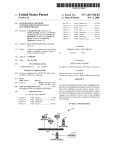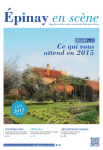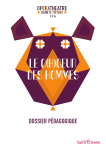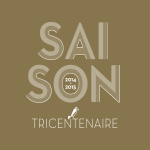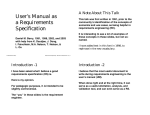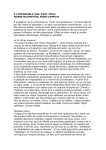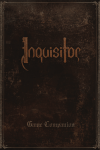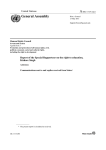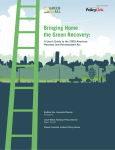Download User's Guide - Office national du film du Canada
Transcript
User’s Guide CO-PRODUCTION OF FIERCELIGHT FILMS AND THE NATIONAL FILM BOARD OF CANADA FIERCE LIGHT User’s Guide W HEN SPIR IT M EETS AC TION Introduction Fierce Light brings together the personal search for spiritual growth with community action. It highlights the struggles of people fighting for a variety of causes in different times and places. The link between these individuals is a strong sense of their own spiritual beliefs, and how these beliefs lead to action. This guide is designed for two different groups: 1) Educators, for use with students at the secondary and post-secondary level 2) Participants at community screenings of the film. You should decide which activities make the most sense for your group or organization. Most of the activities stand on their own, so you can pick and choose the ones you would like to use. Before Screening We highly recommend that teachers watch the film before screening it with students. Before students watch the film, think about what they may know about the notions of spiritual activism and peaceful warriorship, as well as about the particular resistance movements highlighted in the film (eg the US Civil Rights movement, Gandhi’s resistance to British occupation, and anti-globalization protests). Teachers may want to provide some background about these movements in order to prepare for watching the film. KWL One useful tool – for both student and community groups – is a KWL chart. There are a number of KWL charts available for printing online, such as this one: <readingquest.org/pdf/kwl.pdf>. A KWL (this tool was developed by Donna Ogle, in 1986) is a table with three columns to record the students’ ideas on 1) what they already KNOW about a topic prior to engaging in any learning activities, 2) what they WANT to know about it and 3) what they LEARNED after the project or activities were completed. It is great for activating prior knowledge and encouraging students to keep track of their learning. Once everyone has filled in their own charts, these can be shared on a whiteboard or flip chart. Students / Participants fill in the first two columns before viewing the film, and the last column while watching and after viewing. As viewers learn more, the KWL becomes a dynamic tool. By looking for answers to their questions and completing the last column as they learn (as well as identifying and correcting erroneous prior knowledge listed in the first column), they create an interactive record of their learning and amass excellent discussion material. You can find links for leading a KWL here: <olc.spsd.sk.ca/DE/PD/instr/strats/kwl>. 1 FIERCE LIGHT W HEN SPIR IT M EETS AC TION User’s Guide There are two ways to lead a KWL: 1. Students/Participants fill out the first and second column of the KWL individually and then share their ideas during a class discussion. At that time, the teacher records their ideas on the master KWL, which will be posted throughout the project. Then, throughout the project and/or at the end of certain activities, the process is repeated for the last column (What did we learn?). 2. The teacher/ facilitator leads class discussions to brainstorm ideas on filling in the K and W columns. Then, throughout the project and/or at the end of certain activities, the process is repeated for the last column. Vocabulary It may be helpful to introduce the terms below before screening the film, to deepen students’ understanding. Alternatively, groups of students could be asked to write their own definitions of one or two terms, and to refine them as they watch the film. The Fierce Light website offers a more extensive glossary, including names of organizations featured in the film. It can be found at <fiercelight.org/glossary>. Apartheid: The legal system of racial segregation used in South Africa from 1948 to 1994. Under apartheid, black South Africans were not allowed to vote, and they lacked many other fundamental rights. Other groups, such as those called “coloreds” (often of Indian origin, like Gandhi) also faced discrimination, although not to the same extent as black South Africans. Ashram: In ancient India, a secluded community where sages lived in peace and tranquility amid nature. Also the home of a spiritual teacher, or a place for community living, usually with spiritual underpinnings. Gandhi’s Phoenix Ashram in South Africa was his first experiment in communal living. Caste System: A traditional Indian social structure, in which a person’s social class is determined by birth. Dalit: Once known as outcastes, or untouchables, Dalits have traditionally faced discrimination in India and been relegated to the most menial jobs. Discrimination against Dalits continues, although it is now illegal. Dharma: Buddhist teachings and the Buddhist path. Noah Levine and other “Dharma Punx” are punks who practice Buddhism or Buddhist meditation. Free Trade Agreement of the Americas: A proposed agreement that would go beyond the scope of the North American Free Trade Agreement, and which would cover 34 countries in the Americas. Negotiations on the agreement drew mass opposition and protests – including the 2001 protest in Quebec City. The FTAA was never finalized. Luna: A 1,000-year-old redwood tree near the town of Stafford, California. To protect Luna from being cut down during a logging operation, Julia Butterfly Hill lived in the tree – 55 metres above the ground – for 738 days. Sacred Warrior / Spiritual Warrior: The notion of the spiritual warrior is different from that of the warrior who fights physical battles. Spiritual warriors are committed to self-awareness and non-violence. They are humble and use their non-violent strength to bring about change on behalf of humanity. Soul Force (or Truth Force): The English translation of the term “satyagraha,” which was coined by Gandhi to describe a force born of truth and love, and a movement dedicated to living by truth and acting through non-violent resistance. It has influenced many others, including Dr. Martin Luther King, Jr. 2 FIERCE LIGHT W HEN SPIR IT M EETS AC TION User’s Guide Questions for Reflective Discussion Before viewing the film, the teacher hands out index cards to individual or pairs of students. Each card has one question for reflective discussion. The same question can be given to more than one student or pair. While watching Fierce Light, students think about their question. Students must find the answer to their question while watching the film and then participate in a post-viewing reflective discussion. For community screenings, index cards may not be necessary. Select the questions that are most relevant to your group. Here is a list of possible questions for use with Fierce Light. • • • • • • • • • • • • • • • • • • What is spiritual activism? In your life, have political action and spiritual beliefs ever come together? Before watching Fierce Light, did you imagine a connection between spiritual beliefs and activism? What do you think now? Name two specific current issues in the film and discuss the fight activists are waging to make change. In the film, director Velcrow Ripper asks, “Why should I keep working to change the world when we’re up against impossible odds? How can I even think about spirituality when they’re killing my friends?” How would you answer these questions? Is there any point in fighting forces so powerful? Contrast the two demonstrations near Fort Benning. One is organized by people opposed to the School of the Americas, which has been accused of training torturers. The other (“God Bless Fort Benning Day”) celebrates the military. What is the role of spirituality and religion in these two events? At God Bless Fort Benning Day, Pastor Emanuel Wiggins describes spiritual activism as “learning, studying and telling others about our Lord Jesus Christ.” What do you think about this answer? Why does anti-FTAA protester Carly Stasko get up and dance while protesters are being bombarded with tear gas? How do you understand the term spiritual warrior? What kind of fighting would a spiritual warrior engage in? The film says that very different actions – like the fight to save the South Central Farm in LA, the anti-free-trade protests, the US civil rights movement, and the fight for Dalit rights – are part of one world-wide movement, or awakening. What do you think? Are they connected? If there is an emerging worldwide movement, how would you define it? What are its elements? Why does Sera Beak tell the parable of the blind men and the elephant? Judy Rebick says, “Democracy and justice is greater than the power of guns and money.” What do you think? Are they? Are there moments in the film when guns and money seem more powerful? Do you think they will win out in the end? What links the spiritual activists we meet in the film? Are there similarities in their beliefs? Their approaches? Their attitudes? Why do you think Velcrow Ripper set out to make this film? What was his purpose? Does he succeed? Velcrow Ripper isn’t an outside observer. Right from the start of the film, he places himself in the story (in talking about the South Central Farm, he says, “We managed to raise the developers’ full asking price” not, “They managed to raise...”), Why does he do this? How would the film have been different if he was not a part of the story? Throughout Fierce Light, the filmmaker uses images to hint at the possibility of a better world. Can you identify three of these sequences? Are there any moments from the film that will particularly stay with you? What are they? Why are they so powerful? 3 FIERCE LIGHT User’s Guide W HEN SPIR IT M EETS AC TION After Screening A Moment of Reflection One of the participants in Fierce Light defines spirituality as “silence.” Before embarking on a discussion of the issues in the film, it may be helpful for the teacher or group facilitator to encourage a moment of silence and reflection. Members of the group may want to think about those who have fought and died in some of the struggles shown in the film. This could also be a time to lead the group in a calming visualization, or in a few moments of meditation. A simple form of meditation, which is not connected to any particular religious tradition, is to simply sit (either cross-legged on the floor, or in a chair), with eyes closed or looking down at the floor, focus on your breath, and note your thoughts as they arise and subside. Note that even simple meditation practices can be challenging for people who are not accustomed to them. If your group does not include experienced meditators, more than five minutes is not recommended. Viewers may have strong reactions to Fierce Light. The purpose of visualization, meditation or any other reflective practice is to create some stillness – a moment for people to step back and gather their thoughts before entering into a discussion. This should also help ensure the reflective character of the discussion. Reflective Discussion Have students with the same question pair up and discuss their findings. Lead the reflective discussion by asking students to share their answers with the class. Allow for a few comments from others. Tip: To encourage the participation of those who are less vocal in a class discussion, tell one or two students what the next question is going to be and that you would like them to share their opinion or idea on that topic. This will give these students a chance to think about what they would like to share with the group before being called on. You can find more tips on how to lead a reflective discussion here: <olc.spsd.sk.ca/DE/PD/instr/strats/reflectivediscussion/index.html> Making Connections Students choose an issue – local, regional, national or global – in which activism is inspired by spirituality or a sense of the sacred. (Examples might include climate change, disputes over development of land claimed by Aboriginal people, protecting land from clearcutting or anti-poverty activism.) Then they find newspaper articles, magazine stories, blog postings or short online videos that touch on the issue. (If they are finding videos, make sure the classroom is set up so that others can watch them – ie, YouTube and other video sites are not blocked by school board filters, and there are sufficient computers or an LCD projector or SmartBoard available for screening.) Once students have selected a subject and found materials, they talk about it to the others. If they choose, they may form groups based on common subjects presented in the articles. As a group, they then discuss and prepare a summary of their subject and its relevance to the film. Who are the people on either side of the issue? What is the role of faith groups or of individuals acting out of spiritual convictions? Is there a coalition of groups involved in the issue? Which ones are informed by spiritual convictions? 4 FIERCE LIGHT W HEN SPIR IT M EETS AC TION User’s Guide Tip:For full participation and cooperation from all members in the groups, roles and responsibilities can be assigned for this part of the task. They can include: • Data collector: retrieves and verifies the information provided by all team members • Summarizer: summarizes the information for the recorder • Editor: organizes the information for the recorder and presenter • Recorder: records information • Timekeeper: ensures that team stays on task and on time • Presenter: presents information to the class From the Film to the Real World Working as individuals or in groups, students choose one of the struggles in the film and research it further. If the issue is ongoing (eg, the threat of environmental disaster), what roles do you as an individual, or as a group, think you could play in making change? What specific actions could you take or encourage others to take? If it is historical (such as the US civil rights movement), has the movement been a complete success? Does more work remain to be done? What role could you play in improving things even more? Reaching Out Working in groups (or, in the case of a small community screening group, as one group), members choose an issue of concern, either on a local or larger scale. It should be an issue they feel strongly about and would like to be personally involved in. Why did you choose this issue? What spoke to you about it and made you want to take action? How does the issue align with your values? Depending on their skills and preferences, groups can use a variety of approaches to take action. Ideas include: staging a guerrilla theatre event, writing letters, shooting a video, creating a poster, setting up a website or online group, or organizing a public meeting. Many of the struggles that Fierce Light highlights took place in the past. However, there are many causes needing action, and young people can play a critical role. If you are working with a youth audience, it can be helpful to highlight organizations that focus primarily on youth working for change. Young people may wish to get involved in these groups, or to use them as inspiration and examples of what youth working together can achieve. The Otesha Project <www.otesha.ca> is a group of young people dedicated to promoting sustainability. Their Triple-H (Hopeful High School Hooligans) program mixes fun with a powerful message about sustainable living. Other projects include workshops, books, cycling tours, and performances. Me to We <www.metowe.com> was founded by Craig Kielburger of Free the Children. It is a group of youth creating global change through daily choices. The group’s site says, Me to We is “a way of thinking and acting at every level, and a global network of social enterprises, options and ideas unlike any other.” The NFB film Hannah’s Story <onf-nfb.gc.ca/eng/collection/film/?id=54288> can also serve as a simple but powerful tool to initiate discussions on positive change. The film, which is accompanied by a study guide, tells the story of an 11-year-old girl whose efforts to help homeless people have led to substantial funds being raised, the construction of a shelter, and recognition by the Prime Minister. 5 FIERCE LIGHT W HEN SPIR IT M EETS AC TION User’s Guide Journaling Choose a struggle from the film and do further research into the issue. Imagine that you are involved in the struggle. Imagine it is the end of the day. Write a journal entry describing what happened during the day, why you are participating in this struggle, and what your inspiration was for getting involved. You could make up a character and imagine they were there, or you could take on the persona of a real person. Be as specific as possible. For example, don’t just write a journal entry for someone involved in the civil rights movement. Research a specific incident at a specific place (such as the Selma to Montgomery march). Possible ideas: • • • • • • • • • • • • • A participant in the Selma-Montgomery march. One of the participants in the demonstrations in Oaxaca, the day Brad Will was killed. The angel in Oaxaca on the day of her “performance.” Julia Butterfly Hill during the Luna tree sit. Julia Butterfly Hill on the day David “Gypsy” Chain was killed. Julia Butterfly Hill on the day she came down out of Luna. A member of the School of the Americas protest who is carrying one of the crosses and calling “Presente.” One of the children growing up with the South Central Farm central to their lives. Daryl Hannah, a celebrity, waiting in a tree and facing arrest for the first time. One of the adult farmers who have used the South Central Farm as a way to provide for their family and community. A member of Thich Nhat Hanh’s mission to Vietnam, returning to that country for the first time since the war ended. A member of the Dalit community preparing to testify in court against a higher-caste aggressor. Carly Stasko on the day she danced at the Quebec City protest. Getting Personal Given sensitivities with regard to religion in schools, this discussion may be best suited to community screening groups. Following the screening, individuals examine and discuss their own views on spirituality and how these have informed their lives. Is spirituality personal and separate from the political sphere or do they inform each other? Do members of the group regularly attend religious services or participate in religious practices? In your congregation/group/ meditation practice, does social service or social action come up? In what ways? How could you help foster a greater sense of commitment based on the spiritual among others in your community? Making a Case Form groups to research and debate either side of one of the issues in the film. Below are some suggestions for debates. Developers vs. protesters fighting to save the South Central Farm State forces in Oaxaca vs. pro-democracy citizens in Oaxaca School of Americas protester vs. God Bless Fort Benning organizer Another possible topic for debate is the question of the role of spirituality. A debate could be organized on a topic such as the following: “Spirituality is a personal choice and should not play a role in political activism.” 6 FIERCE LIGHT User’s Guide W HEN SPIR IT M EETS AC TION Online The Fierce Light website <fiercelight.org> allows you to take your experience of the film to another level. Students will find plenty of starting points for further research. And there is a lot here for people wanting to become more deeply involved in promoting the film or in activism. Read biographies of the visionaries featured in the film, along with some of their key quotes. Learn more about spiritual activism and contact organizations putting it into practice. Take action to spread the word about the film. Read the blog and continue the conversation with your own comments. Here is a selection of other websites (including some for groups featured in the film). Friends of Brad Will <friendsofbradwill.org> provides news and opportunities to take action on causes related to Brad’s life and work. In Spanish and English. Green for All <greenforall.org> is the organization founded by Van Jones and dedicated to building a green economy that will provide widespread employment and prosperity while protecting the environment. Congressman John Lewis is online at <johnlewis.house.gov>. The Engage Network <engagenet.org> works with small groups to engage people socially and train leaders. They focus on encouraging people to connect in small groups and ignite – or re-ignite – their passion for working for change, using yoga as a springboard for activism and training leaders for the green economy. Noah Levine’s site <dharmapunx.com> includes his teaching schedule, links to various Dharma Punx inspired groups, and mp3s of talks. Avoid the forum, which has largely been filled with spam. School of the Americas Watch <soaw.org> describes itself as “an independent organization that seeks to close the US Army School of the Americas, under whatever name it is called [the name has been changed to Western Hemisphere Institute for Security Cooperation] through vigils and fasts, demonstrations and nonviolent protest, as well as media and legislative work.” They organize the annual demonstration against the school. Julia Butterfly Hill has a blog at <juliabutterfly.com>. Also, visit <imdb.com/title/tt0810952> for information about the Hollywood film based on her Luna tree-sit. The Network of Spiritual Progressives <spiritualprogressives.org> “is an interfaith organization open to progressive people who are religious, or ‘spiritual but not religious,’ or secular people who understand the need for a politics of meaning and a spiritual/ religious Left and wish to support efforts to build it.” Although they have been evicted from their original farm, the South Central Farmers <southcentralfarmers.com> continue to farm, and to fight. The Baha’i Faith site <bahai.org> offers an introduction to the religion and its texts as well as links to Baha’i communities around the world. 7 FIERCE LIGHT W HEN SPIR IT M EETS AC TION User’s Guide The iconoclastic Sera Beak <serabeak.com> calls herself a “Harvard-trained scholar of world religions and intrepid spiritual cowgirl who spent the last 12 years traveling the world exploring spirituality.” Activist and author Judy Rebick’s blog takes the name of one of her books: <transformingpower.ca>. Plum Village <plumvillage.org> is the name given to the community of practice of Vietnamese Buddhist monk, poet, scholar and peace activist Thich Nhat Hanh. The site includes articles on mindfulness and practice, as well as a schedule of events. The Desmond Tutu Peace Centre <tutu.org> promotes conflict resolution, peace and social justice in South Africa and around the world. Its mission states that “peace will flow out of justice” and that “there is essential good in everyone.” Related Resources from the National Film Board of Canada This section includes a list of films relating to spirituality and activism from the National Film Board of Canada’s vast collection. These films have been chosen for a variety of reasons. Some feature activists whose work is rooted in a sense of the spiritual; others feature struggles and issues related to those in Fierce Light (for instance, Journey to Justice is about the Canadian Black civil rights movement). Please note that some films are available free at <nfb.ca>. Simply go to the site and enter the name of a film in the search bar. The NFB is constantly making new videos available online, so you may want to check <nfb.ca>, even if this guide does not say it is currently available. If you are looking for a film that is not online, or prefer to order a DVD, please visit <nfb.ca/store>. Scared Sacred In Velcrow Ripper’s award-winning previous film, he sets out on a unique pilgrimage – visiting the “Ground Zeros” of the planet and asking if it’s possible to find hope in the darkest moments of human history. Through a five-year odyssey, Ripper travels to the minefields of Cambodia, war-torn Afghanistan, the toxic wasteland of Bhopal, post-9/11 New York, Bosnia, Hiroshima, Israel and Palestine – trying to discover if humanity can transform the “scared” into the “sacred.” At each Ground Zero, he unearths unforgettable stories of survival, ritual, resilience and recovery. (2004, 105 min) <scaredsacred.org> and <nfb.ca/scaredsacred> A Place Called Chiapas On January 1, 1994, the day the North American Free Trade Agreement came into force, the indigenous Zapatista National Liberation Army (EZLN) took over five towns and 500 ranches in southern Mexico. Three years later, the Zapatistas and their charismatic leader, guerrilla poet Subcomandante Marcos, are trapped in the Locandon jungle. Surrounded by 30,000 Mexican troops, they struggle to maintain a nervous ceasefire. Despite on-going peace talks, hundreds have been killed. Director Nettie Wild travels throughout the jungle canyons of Chiapas to capture the elusive and fragile life of a revolution threatened by right-wing paramilitary death squads. On camera, the death squads accuse the Zapatistas of violence. Off camera, they threaten to kill the film crew. Through eight months of filming, Nettie Wild takes the audience with her on a personal journey through fear, hope and illusion. (1998, 92 minutes) 8 FIERCE LIGHT W HEN SPIR IT M EETS AC TION User’s Guide On the Road With Mary A few months before the 2004 presidential election, documentary filmmaker Monique LeBlanc travels through the United States, meeting people who are inspired to acts of compassion by the Virgin Mary. Working on the fringes of the system, these low-profile rebels have become deeply involved in their communities and have taken it upon themselves to help those who are less fortunate than themselves. A poetic, political, personal and universal film. (2005, 80 minutes) Salvation A documentary about front-line street workers who serve the needy under the umbrella of the Salvation Army. One of the world’s largest social agencies, the Army is a religious institution that serves the practical needs of people first, in the belief that religion is of little use to someone who is hungry, homeless and hopeless. Salvation is a meditation on the nature of goodness. Shot in the streets of Toronto at Christmastime, the film chronicles the small hopes and tiny victories of life lived in the shadows of destitution, and the daily rewards for those who work to serve others. (2001, 51 minutes) What Remains of Us Since he was forced into exile by a Chinese invasion 50 years ago, the Dalai Lama – Tibet’s spiritual leader – has never been able to directly address Tibetans who have not fled the country. Kalsang Dolma is a young Tibetan refugee who lives in Quebec. Between 1996 and 2004, she crosses the Himalayas on a dozen secret trips into Tibet. She brings with her a small camera carrying a video message from the Dalai Lama. Families gather around the tiny screen, transfixed, to hear him speak – and then to tell us directly about their experiences. This film was shot using small digital cameras, without the approval of the Chinese authorities. (2004, 76 minutes) A Song for Tibet Tibetans have been struggling for cultural and political survival since their land was invaded by China in the 1950s. Filmed in the Indian Himalayas and in Canada, A Song for Tibet tells the dramatic story of the efforts by Tibetans in exile – including the country’s spiritual leader, the Dalai Lama – to save their homeland and preserve their heritage. (1991, 57 minutes) Watch it free at <nfb.ca>. Journey to Justice Journey to Justice tells the little-known story of Canada’s civil rights movement, profiling the brave Canadians who led the fight for equality from the 1930s until the 1950s. Viola Desmond quietly made history in 1946 when she refused to move from a theatre seat in New Glasgow, N.S. Donald Willard Moore helped reform Canada’s biased immigration policy. Hugh Burnette founded the National Unity Association after returning from WWII only to find that he and other Black citizens were refused service in a local restaurant. Stanley G. Grizzle was active in the Brotherhood of Sleeping Car Porters, and his activism resulted in the enactment of the Fair Employment Practices Act. Journey to Justice serves as a powerful testament to the contributions they and many others made to the evolution of Canadian democracy. (2000, 47 minutes) Half a World Apart... And a Lifetime Away In 1995, First Nations leader Grand Chief Ovide Mercredi made a pilgrimage to India after a summer of violence and standoffs near two reserves. There, he met with followers of Gandhi who practice non-violence. A highlight of the trip was a conversation between Mercredi and Gandhi’s grandson Rajmohan. In this intimate portrait, which chronicles an unusual journey, one leader explores the life and teachings of another. In doing so, Mercredi confirms his belief in the necessity of non-violent political action. (1996, 52 minutes) 9 FIERCE LIGHT W HEN SPIR IT M EETS AC TION User’s Guide The Fight for True Farming In this documentary, crop and animal farmers in Quebec, the Canadian West, the US Northeast and France offer solutions to the social and environmental scourges of factory farming. Driven by the forces of globalization, rampant agribusiness is harming the environment and threatening the survival of farms. The proliferation of GMO crops is a further threat to biodiversity as well as to farmers’ autonomy. In Europe as well as North America, a current of resistance bringing together farmers and consumers insists that it is possible — indeed imperative – to grow food differently. (2005, 90 minutes) The World According to Monsanto With operations in 46 countries, Monsanto has become the world leader in genetically modified organisms (GMOs), as well as one of the most controversial corporations in industrial history. Since its founding in 1901, the US multinational has faced trial after trial over the toxicity of its products. Today, it has reinvented itself as a “life sciences” company converted to the virtues of sustainable development. Calling on previously unpublished documents and first-hand accounts by victims, scientists and politicians, The World According to Monsanto pieces together the story of an industrial giant that – thanks in part to lies, collusion with the American government, pressure tactics and attempted corruption – has become one of the world’s leading seed manufacturers, spreading GM crops worldwide with no real monitoring of their effects on nature or human health. (2008, 109 minutes) Faith Without Fear In Faith Without Fear, controversial author and outspoken Muslim Irshad Manji asks herself: How has Islam, a religion of justice, become mired in fear? Manji journeys through the Middle East, Western Europe and North America on a mission to reconcile her faith in Allah with life in the 21st century. (2007, 56 minutes) <nfb.ca/faithwithoutfear> Me and the Mosque Zarqa Nawaz – creator of the popular TV series Little Mosque on the Prairie – visits mosques throughout Canada and talks to scholars, colleagues, friends and neighbours about equal access for women. Discussions about the historical role of women in the Islamic faith, the current state of mosques in Canada and personal stories of anger, fear, acceptance and defiance punctuate this film. And Nawaz herself speaks of the spiritual longing that comes from belonging to an institution that doesn’t want you. (2005, 53 minutes) Four Women of Egypt Four friends have the same goals, promoting human dignity and social justice. They are inspired by love of country, but each adopts a radically different approach. Whether Muslim, Christian, or non-religious, each woman has her own vision for a new society. In French with English subtitles. (1997, 89 minutes). If You Love this Planet This Oscar®-winning short film is based on a lecture by outspoken anti-nuclear activist Dr. Helen Caldicott, president of Physicians for Social Responsibility in the United States. Archival film footage of the bombing of Hiroshima and images of its survivors seven months after the attack heighten the urgency of her message. A peace movement classic. (1982, 26 minutes) Watch it free at <nfb.ca> 10 FIERCE LIGHT W HEN SPIR IT M EETS AC TION User’s Guide Speaking Our Peace Filmed in Canada, Britain and the then-USSR, this documentary focuses on local and international peace initiatives by women. Featured in the film are well-known writers and activists Rosalie Bertell, Marion Dewar, Muriel Duckworth, Ursula M. Franklin, Darlene Keju, Margaret Laurence, Solanges Vincent and Kathleen Wallace-Deering. In interviews and during encounters with Soviet women, they outline their views on war and peace. The film includes scenes of women in mass demonstrations at Litton Systems Canada and at Greenham Common in England, as well as footage of ordinary citizens who must live with the health and environmental problems caused by uranium mining and nuclear weapons testing. (1985, 55 minutes) Poverty, Chastity, Obedience At 35, Joanne O’Regan feels God has called her. She socializes, smokes, drinks and isn’t thrilled about the secondary role women play in the Catholic Church. But she decides to join the Sisters of St. Martha, whose vision encompasses service and community involvement. Before taking the ultimate leap of faith, Joanne is forced to confront her demons, her motivation, and her family and friends. (2002, 52 minutes) Sister Kay Kay MacDonald entered the Sisters of Sion convent in Saskatoon in 1949 and went on to be elected leader of all Catholic nuns. One of her driving ambitions was to transform the Church’s deep-rooted anti-Semitic views, and she was instrumental in ending the Church’s policy of trying to convert Jews to Christianity. As this film travels from the Canadian Prairies to the Vatican to Jerusalem, Sister Kay emerges as an inspiring leader who promotes reconciliation among people of all faiths. (2000, 45 minutes) H a n n a h ’s S t o r y Hannah is an 11-year-old girl whose efforts to help homeless people have led to substantial fundraising, the construction of a shelter, and recognition by the Prime Minister. (2007, 29 minutes) Film Credits: Written, Directed and Photographed by Velcrow Ripper Produced by Cher Hawrysh Producer for the NFB Gerry Flahive Executive Producers Mark Achbar, Betsy Carson and Silva Basmajian (NFB) Produced by Fiercelight Films in co-production with the National Film Board of Canada Produced in association with Telefilm Canada and Big Picture Media Corporation Canada User’s Guide USA International Written by Phil Moscovitch Internet Graphic Design by Agripino Monteiro This user’s guide draws on the Films for Change template, developed by the McGill Centre for Educational Leadership, the National Film Board of Canada and Leading English Education and Resource Network This User’s Guide is available for download at <nfb.ca /guides> © 2009 National Film Board of Canada 1-800-267-7710 1-800-542-2164 1-514-283-9000 nfb.ca [email protected] nfb.ca/fiercelight fiercelight.org 11












